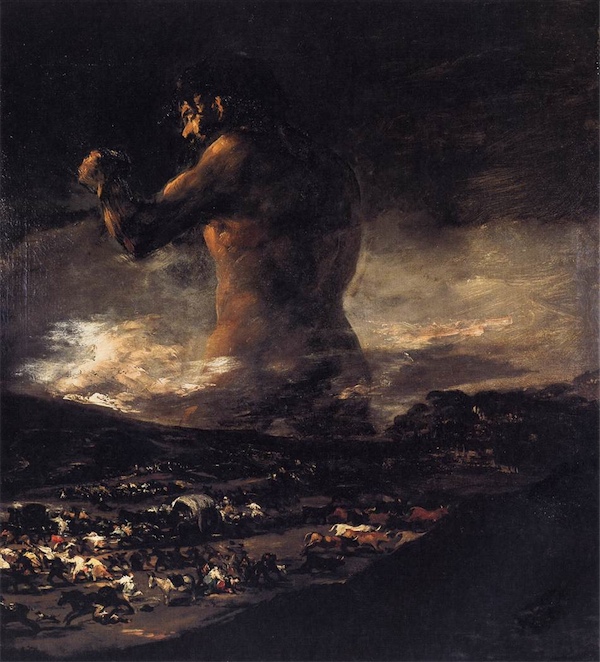
Ved, que sobre una cumbre
De aquel anfitëatro cavernoso.
Del sol de ocaso á la encendida lumbre
Descubre alzado un pálido Coloso,
Que eran los Pirinéos
Basa humilde á sus miembros gigantëos.
Cercaban su cintura
Celages de occidente enroxecidos,
Dando expresión terrible á su figura
Con triste luz sus ojos encendidos;
Y al par del mayor monte,
Enlutando su sombra el horizonte.
Look, upon the summit
of that cavernous amphitheater,
flooded with light by the setting sun
a pale Colossus discovers his prize
what were once the Pyrenees
reduced to humble stumps when compared with his gigantic limbs. ?
Ruddy colored clouds of the West
Encircle his waist,
giving terrible expression to his shape
?
as sad light ignites his eyes;
and to match the great slope,
?
Enlightening the horizon with his shadow.
—Juan Bautista Arriaza, Profecía del Pirinéo in Poesías patrióticas, pp. 27-40 (1810)
Last year when the Prado was staging its Goya in Times of War exhibition, a painting that would have been expected to be accorded pride of place–the Colossus–strangely disappeared. It soon became apparent that the painting was missing because art world experts, including some of the museum’s own leading Goya authorities, had begun to question whether this painting was actually Goya’s. In the process of the painting’s cleaning and restoration, the initials “A.J.” had been discovered in a corner of the canvas. Speculation developed that the painting was actually not the work of Goya, but rather an artist who collaborated in his studio, Asensio Juliá. After a careful review, the Pado decided in January to drop the attribution to Goya but concluded it was still unclear who had painted the work–though it almost certainly came out of his studio. El País summarized: “goyesco sí, de Goya no.”
This work was one of the best known paintings attributed to Goya. It had assumed a focal role in the portrayal of Goya as a liberal patriot who supported the rising against the French during Spain’s bloody war of independence. It was tied closely to a poem by Juan Bautista Arriaza, a Spanish poet and politician who helped inspire the rising–whose portrait Goya had painted. The image of the colossus is ripped straight from his Prophecy of the Pyrenees, down to the ruddy clouds that encircle his waist and his gait in the mountains. It had been the subject of innumerable articles lauding the power of its composition and images. Goya was often portrayed as the man who opened the door to modernity. This painting played a key role in those arguments.
Does the building consensus that Goya did not paint this work now necessitate a reassessment of Goya and of this painting? These questions are likely to be discussed for some time. But Goya’s role within the Spanish canon is secure with or without this painting. Similarly, Goya’s attitude towards the French occupation, the rising against it and the repression that followed the restoration is firmly anchored in many other works. But is the Colossus by any measure a lesser work because it was not painted by Goya? Obviously not.
Have you ever walked in the evening among the bustling restaurants and cafés of Madrid around the Plaza Mayor? The place has its own peculiar energy. It defines Madrid, and in a sense, Spain. Now listen to the Musica notturna delle strade de Madrid of Luigi Boccherini from the string quintet, op. 30, no. 6 (1780)–a musical expression of this ambience.
This music has a fascinating progency. Boccherini was the composer to the Spanish Infante Luis Antonio, the brother of King Carlos III, and the Cardinal-Archbishop of Seville and Toledo. When Luis Antonio renounced his clerical offices and married a commoner out of love–against the king’s wishes—a scandal resulted. He and his entourage were exiled to Ávila. Boccherini followed him, but was filled with longing for the vivacious nightlife of Madrid, and he recorded it in this music. In it, we walk through the streets of the inner city, listen to the bustling dance tunes of a café and walk on until finally the curfew is announced in the famous ritirata de Madrid, the music sounded by the local garrison. As Elisabeth Le Guin tells us in her study, Boccherini’s Body: An Essay in Carnal Musicology, Boccherini felt this work would never be understood by outsiders: “The piece is absolutely useless, even ridiculous, outside Spain,” he wrote to his friend Pleyel, “because the audience cannot hope to understand its significance nor the performers to play it as it should be played.” But he was wrong—in fact, expressive, daring performances of the Musica notturna fueled a revival of interest in Boccherini’s music in the twentieth century, and the ritirata became his musical signature. In it we see a consummate classical composer drawn into the passion of popular music. Boccherini was an Italian formalist, but somehow during the long stay in Ávila he was transformed into a Spanish musical patriot. He died in 1805, impoverished, suffering from tuberculosis and widely viewed as a musical has-been. Today, however, he is rightly appreciated as the definitive composer of Spain through the galant era and the early troubles launched by the French revolution. Boccherini’s life and career closely parallel those of the court painter Francisco Goya, with whom he was acquainted.



